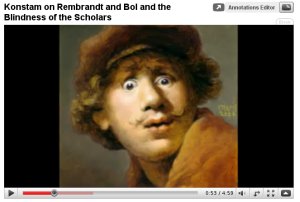When he opened my second exhibition at Imperial College Prof. Sir Ernst Gombrich described me as “having prepared a great feast for art historians at which I invited them to eat their own words” I took it as a joke, knowing that the power of the evidence gave them no option but to rethink. (I have precised much of the evidence on this blog and on www.saveRembrandt.org.uk)
Now, thirty years later, I have to acknowledge that what still appears to me as irrefutable evidence can apparently be passed off as simply a personal opinion that can be ignored by the great Rembrandt establishment; and they have got away with it. Their colossal misjudgments, (Paraded in “The Rembrandt and his Workshop” series of exhibitions in Berlin, Amsterdam and London; and again most recently at the Getty) seem to provoke no descent . Why has there been no public outcry?
Has Art become such a specialist subject that no one presumes to question the “experts” even when the evidence is perfectly clear that they are mistaken? In the case of Rembrandt they have dragged him down in the last forty years from a position of the greatest eminence to one in which he is no longer trusted.
For my first exhibition I earned a number of accolades from art historians (as opposed to Rembrandt specialists) that led me to see myself as a rising star. Benedict Nicholson, editor of The Burlington Magazine wrote “ I find the evidence you have accumulated of the greatest possible interest as I am sure will Rembrandt scholars, who must now get down to revising the corpus of drawings!” Later Prof. Sir Lawrence Gowing of the Slade, himself an eminent painter, wrote, “Your view of the division between objective and imaginative seems to me artistically and psychologically much more comprehensible and satisfactory than anything before”. I have not met an artist who would disagree with that.
How many of our art experts have any experience of practical art? Very few I would imagine. I find their corporate published judgments appalling. Are people happy with the state of art in our time? Am I in a minority seeing the state of art as decadent beyond belief ?
How has it happened so very quickly? The power of the experts has increased exponentially as the technology of art publishing has blossomed. They now rule the world of art for the first time: They dispense government money, manage the prestige galleries, give the prizes, buy for the museums, advise the publishers, and rule the auction houses. It is a terrible situation that needs to be reversed, immediately. I’d like to curate a show demonstrating the folly of the expert’s that would include all the Rembrandts they have irresponsibly deattributed.
The specialists may refuse to rewrite their texts but there is still a great feast to be had in honour of the Greater Rembrandt: Rembrandt the Observer, once known as “the first heretic in art”. The experts have transformed him into the classic inventor, presumably because this is what they prefer. There is sparse evidence for this idea and plenty of evidence to the contrary. In the transformation we have lost more than half his works and more importantly we have lost sight of Rembrandt’s great message to the world: Take off your classical blinkers and see the wonders of the world as it is, through observation. (he was a part of the great scientific/philosophic revolution taking place at his time; mainly in Amsterdam). No artist said this more clearly and consistently than Rembrandt. “He was taught by nature and by no other law” (Houbraken).
All that is needed is a change at the top. The real Rembrandt is still discernible but we must act before we lose sight of him completely. Artists must seize back their lost initiative in art.
Currently there are two theories as to how Brunelleschi arrived at his rules of perspective, which deserve consideration but with which I cannot agree. David Hockney has demonstrated that Brunelleschi could have used a lens to throw the image of the Baptistery onto a surface on which it could then be traced. I could accept this theory if it were not for the evidence of Manetti, a friend of Brunelleschi’s, who had “held the painting (of the Baptistery) in his hands and seen it many times”. I have a second objection to Prof. Martin Kemps preferred theory (he actually lists six possibilities, Hockney’s was published after his book and was therefore not included). The second is that Kemp does not seem to take into account that there were many versions of perspective available at the time; and Brunellschi had to make a second demonstration to persuade people that his was the best.
Giotto and the ancients had a pragmatic means of conveying the space in a building or furniture based on it’s appearance. Ambrogio Lorenzetti and Simone Martini refined this perspective around 1330 so that their complete picture space was logical, and Kemp suggests that this perspective was used by Brunelleschi’s friend, Donatello as late as 1417 in his St. George relief, that is after Brunelleschi had made his first demonstration with the Baptistery. The new perspective did not reach Siena till the 1450s! Clearly the first demonstration was too complicated to follow, or perhaps it smacked too much of wizardry, with its use of two mirrors.
The solution that Kemp least favours I proposed in a lecture at the Slade c1978. (I do not suppose that I was the first to propose it) that is that Brunelleschi’s first demonstration was painted on a “a burnished silver” mirror. Manetti’s description says that “Filippo put burnished silver in the sky” but the reason he gives for this strange behaviour “so that the clouds would be seen to be moved by the winds that blow” seems scarcely credible for a man of Brunelleschi’s scientific bent. It diverts attention from the point he is making. I suggest that the Baptistery and surrounds were painted over the silver but Brunelleschi left the sky unpainted to explain his method.
Brunelleschi had to start from an image of reality that no one could question. The mirror image was such an image. The use of silver as the mirror is easily explained: Brunelleschi was a goldsmith, polished silver was the best reflector available and it had the further advantage over glass that one could scribe on its surface very precisely. The reflective surface could be touched without the thickness of glass intervening. Kemps main objection to this “simple” solution is that ones own image would blot out most of the Baptistery but this is not so. Once one has fixed the eye-point and the mirror one is free to move, to use either eye, and to look through the eye-piece with one’s head at what ever angle is convenient. By this method the size of the blot is no bigger than 2 cm in diameter, that is the distance between the pupil of the eye and the outer skull as reflected. This would not have been the slightest impediment as it need not blot out the outer corners of the Baptistery which are necessary points to fix the image. We can be certain that Brunelleschi would not have gone further with the work before analysing the geometry. The paint would have only been applied to clarify the image for others to appreciate how very like it was to the original. Naturally it needed to be turned round the right way this is why the peep-hole and second mirror were introduced. This method is not only the simplest as Kemp admits, it fits Manetti’s description in all but the one particular. Neither Kemp nor Manetti seem to have understood the need for the second mirror in righting the reversed image traced on the silver mirror.
Kemp’s further objections were:-
-
that Manetti could not have been mistaken in thinking that the silver was applied to the sky area only. But clearly if the rest had been painted over why should he not have made this mistake. On the one occasion on which he held it in his hand we may presume he was preoccupied with seeing the image in the second mirror.
-
Kemp goes on – it does not justify Manetti’s claim for Brunelleschi’s geometry. But it does of course require analytical geometry to arrive at the rules of perspective from the scribed image.
-
The second of Brunelleschi’s demonstrations did not require mirrors; adds Kemp. No, that was why it’s straightforwardness finally convinced the doubters. It was presumably arrived at through the perspective geometry derived from the first demonstration.
(see “A Documentary History of Art vol.I.p171-2 . Anchor books 1957 for Manetti’s whole text in English)
This is the real Bol as draughtsman, not very inspired. If anyone has access to better photos of the Bol paintings we would be very pleased to replace the miserable versions we have had to use.
the true Bol
Take this link to see the new YouTube video
Just the other day 65 million pounds ($104.3 million) was paid for one copy of an edition of 6 bronzes of Giacometti’s “Walking Man”. I feel personally indebted to Giacometti as the one among the mega-buck heroes whose drawings should be venerated by posterity.
But surely in a world that is suffering economically and teetering on the brink of climate catastrophe this “investment” by a bank is a disgrace. It can benefit no living person by reward for work or ideas. It brings nothing new into the world. It simply locks up money that could be spent positively. Investors in art might turn their attention to struggling living artists whose ideas they cherish as of probable benefit to mankind in the future.
I first saw Giacometti’s work at an Arts Council exhibition around 1955. As I wandered round the exhibition I was a bit perplexed by the works but within a week my understanding of Rembrandt’s works took a great leap forward.
Giacometti’s drawings are exclusively about space. His attention is always on what I call the space clues: the section round the forms created by the neck-line, waist-line and drapery passing over the thighs or arms. He defines the air/space by the pattern of chair legs and sculpture-stands across the floor or the pictures on the walls. He did not seem to care about anything else.
Through his concentration on space I came to realize that Rembrandt used the intimate space between his characters. It is this intimate space that is the key, I believe, to the expressive quality in Rembrandt’s work. Previously I had been so enamoured of the solid, sculptural quality I had not noticed that space also speaks.
Because of this important insight I received from Giacometti I will always revere his drawings; I do not really understand what people see in the sculptures. They seem to me far less grand than the Etruscan work on which they are based. “The Walking Man” seems to me particularly feeble.
Anne's Vermeer, all but finished.(26 X 16 cm) oil on canvas
The Presepe Vivente was rained off yesterday but that did nothing to cool the enthusiasm for today. Casole was humming 3000 people at least. Besides the Nativiry there were market stalls offering various winter refreshments and skating of course. Here are a few pictures to give you the flavour,
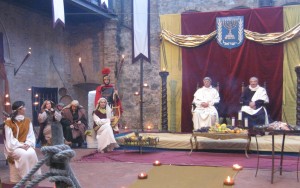
Herods Palace
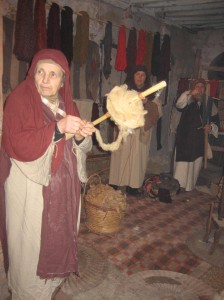
The spinners really know what they are doing
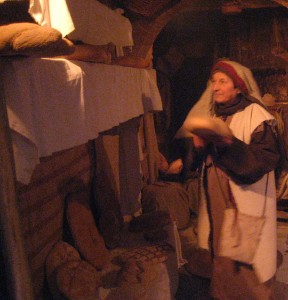
the baker
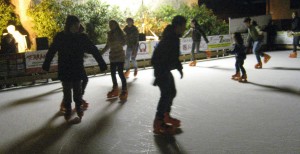
skating
For those of you who are as unfamiliar with blogging as I am – you need to start at the bottom to get a coherent picture. It makes more sense to read it in order of dates. I will not be writing any more about Rembrandt for a bit. There is a book waiting for a publisher since 1978. I will of course reply to Questions or Comments.
with best wishes for Christmas and the New Year, Nigel
Artists speak a lot about “form”. In my day in the sculpture school at Camberwell we were ever conscious that our job was to see form. In three or four years of study I guess 50% of us made it. The rest were given to understand that they needed to find some less demanding occupation (such as Art History). Form was just the beginning, the next step was to see forms adding up to a united structure – the hope was that the forms were so harmoniously united the work became a composition.
Many books on drawing describe form. Raphael is a master of form. In its simplest sense, form consists of those geometrical shapes one might make on a lathe; cones, cylinders or eggs; also blocks or other rectilinear shapes. Durer made a number of demonstrations of figures seen as a series of forms. The artists’ lay-figure is another demonstration of the use of forms which is the clear basis of Raphael’s drawing from imagination, in fact most artists construct drawings in this way. (I would recommend G.B.Bridgman’s Drawing from Life, to those who wish to pursue this idea of form.)
It is a schema that was heavily relied upon during the Renaissance even when drawing from life. It had the negative result of making renaissance drawings a bit clonelike. As a schoolboy I regarded this likeness as necessary to drawing. I rather imagine that most people today are only satisfied that someone “can really draw” when they recognise that likeness in a work. Another common expectation is anatomy, also a renaissance obsession. I do not use the word “form” to mean anatomy, though some do; nor is it just meat. I use the word to denote that more abstract mental concept, which I (and Plato) have described.
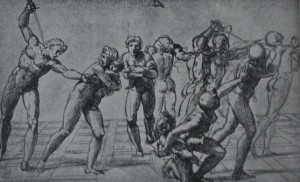
Raphael's Massacre of the Innocents
If we then add to the lay-figure concept the idea of perspective we have defined renaissance syntax. It was a great success up to a point but Rembrandt, probably subconsciously, realized that to express the feelings of his protagonists it was inadiquate. He needed to convey a much more precise sense of the space occupied by his actors in order to “give maximum expression to feeling”. This necessitated a new syntax, of which the “experts” seem oblivious.
A visual demonstration of Rembrandt’s new syntax will be coming shortly on this blog as I cannot point to other sources nor explain it without diagrams.
I named my Art School in Tuscany Italy after the famous ‘School of Verrocchio’ because of my great admiration for the Renaissance Sculptor Andrea Verrocchio who ran the greatest Art school ever known (attended by Leonardo da Vinci, Perugino, Lorenzo di Credi, Domenico Ghirlandaio). Adolf Beyersdorfer in 1876 wrote of Andrea Verrocchio: “Next to his pupil Leonardo, his (Verrocchio’s) is the greatest artistic character that has ever existed. The lofty and strict principles of his studio brought back worth and value to Florentine Art at a time when these qualities were on the point of extinction”.
My 5 minute video about the School of Verrocchio is now available on YouTube
